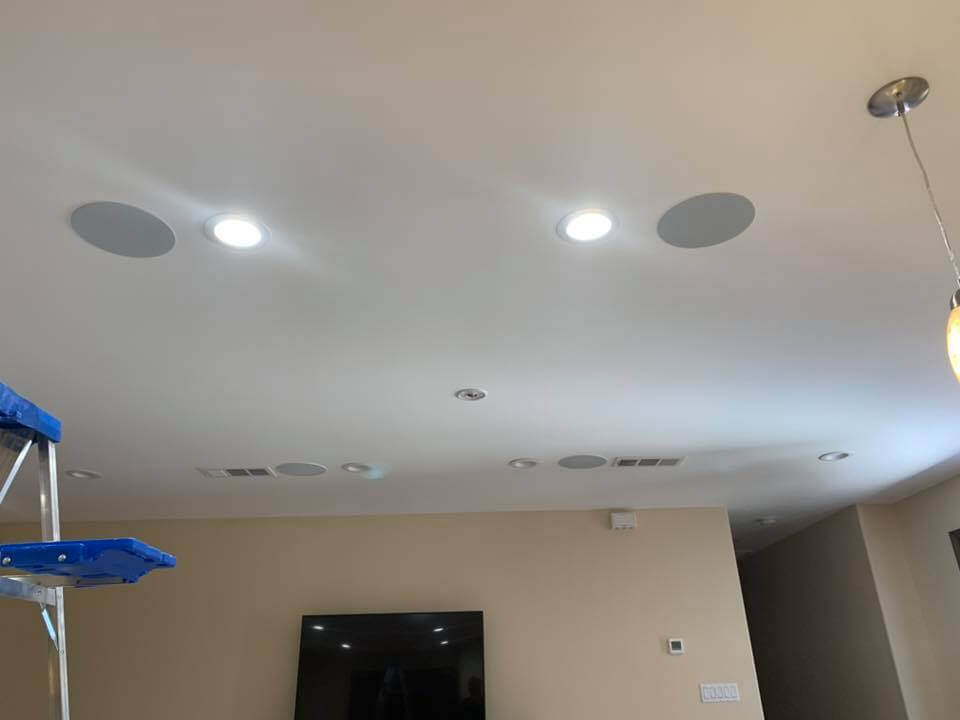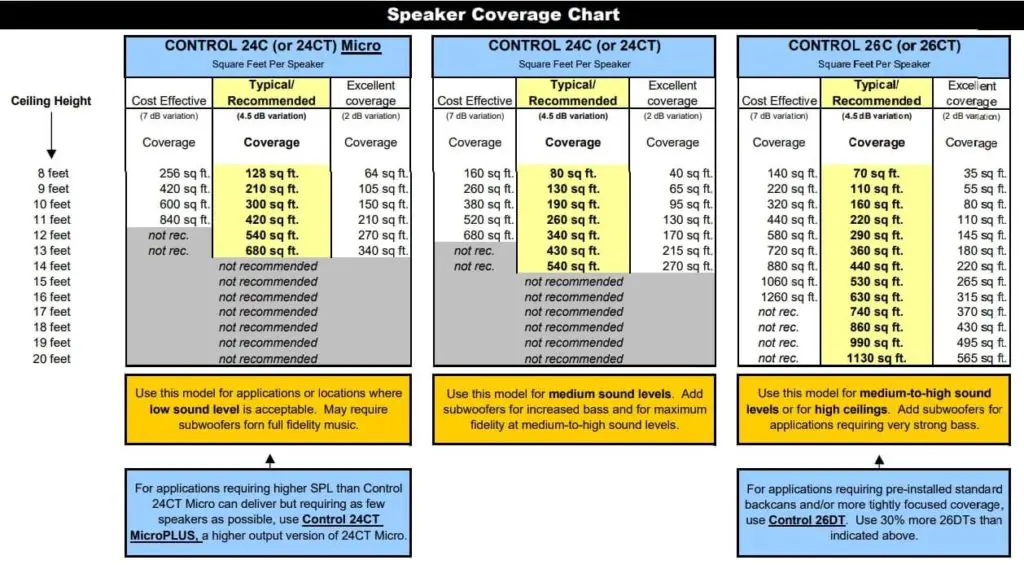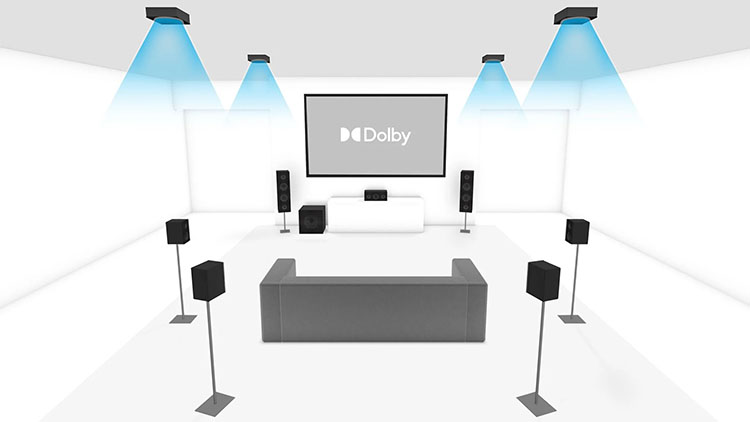Most average rooms would require a minimum of 4 ceiling speakers for the best possible experience. But, for tiny spaces that are around 100 Square feet or above 3 meters by 3 meters, then they can opt for two ceiling speakers because the sounds may collide if there are more speakers.
Aside from that, if you go higher than 200 square feet, then I recommend getting two pairs or four ceiling speakers. Front & Rear and Left & Right. If you go to any professionals, their usual recommendations will be to get four ceiling speakers.
That is what I will focus on, as I’ll break down everything there is to know, from speaker types to what is required for your room, so that you end up knowing everything necessary to get ceiling speakers per square foot.
Speaker Types: should you get active ceiling speakers or passive ones?

Most setups have passive speakers installed, and the answer is relatively simple; it is because passive speakers are required to get themselves plugged in through an amplifier or a receiver. The connection will obviously be close to the cables.
Active Speakers (Not recommended)
Even though active speakers don’t require any external connection, it will be a hassle to find a socket as well as those long cables to connect. And, also the purpose of ceiling speakers is different in the good movement, so for the correct conversion, a multiroom amplifier is required.
Passive Speakers (Appropriate Choice)
If you get passive speakers, you’ll need to compatible amplifier based on the speakers, and it will be close to connecting with the speakers, which are suitable to the wires’ size. Passive speakers also leave a lot of room for the sound’s adjustment based on the environment, unlike active speakers which will be based on their internal amp.
What should be the appropriate size of the speakers?
Based on how you want the speakers settled inside your room, the size of the speakers really matters because it needs to match your aesthetic needs as well as the size of the room. So, here are the size of the ceiling speakers.
1. Small Sized Ceiling Speakers (For your personal rooms)
These are the absolute small variants of speakers that are more suitable for lowkey, minimal rooms or just in general, for a small room where it may be a bit unnecessary to get the larger ones. These are around 5-inch speakers, which in the diameter goes up to 220 mm. The power of these speakers is obviously relatively weak. So, if you go past a room that is over 200 square feet, you should change.
2. Medium Sized Ceiling Speakers (For your typical theater and living rooms)
Now we are inside the appropriate size of the ceiling speakers, which is for the typical sized home theater and living room spaces. Some of the medium size speakers can also look lowkey and minimal, but usually, they have a more noticeable aesthetic. These are 8-inch or higher-sized speakers that have overall diameters up to 260 mm. These speakers have the best-performing sound, which is optimized to give you an immersive experience.
3. Large Sized Ceiling Speakers (For large hall rooms or mini theaters)
These speakers are designed for large spaces and have the crankiest volume, which is exceptionally high in the bass. They provide the best possible sound in terms of a large theater. As well as a costly option because you also need to get a decent amplifier to run such a setup. These are over 10-12 inch sized speakers, which go above 280 mm in diameter. These speakers won’t sound well if you put them in small and medium-sized rooms because the sound will constantly reflect all over the place due to lack of space.
How many ceiling speakers do I need per square foot?
Now that you know which size of speakers are required based on your room and needs, you now need to know how many ceiling speakers are required per square foot.
Know the surface of your ceiling:
Also, I am suggesting all of this based on your room’s surface being flat because if the surface is angular and slanted, then you may need to buy ceiling speakers as well as height speakers, where you need to create a multi-channel setup.
Find out the exact speakers: The Ceiling Speaker Calculator.
We are supposed to base our priority based on the 6-inch – 8-inch size of speakers because that is usually the appropriate size of the speakers. In general, if you had to get ceiling speakers without any prior knowledge for your room, then I’d simply say just to get 2 pairs of ceiling speakers because that is the default to me based on my experience.
As I have discussed above, if only your room is small, like 100 square feet, then you can simply get a pair of 8-inch speakers. Still, if you’re going 200 and above, then four ceiling speakers are a bare minimum. But, if you have smaller speakers, then you can adjust them centrally, adding more speakers.
The calculation:
If you seek to calculate the exact amount of speakers, you need to have for your room. Then, based on the height of your ceiling, which should be at 14 feet mark for optimum sound. Divide the square footage of the room, then divide it by the coverage per speaker. After that, the result will give you the number of speakers necessary. I wouldn’t thoroughly recommend this calculation because you obviously have a better understanding of your own room and what it requires.

Note: If you feel like this calculation is instead a hassle, but you still want a simulated result, then Extron has a calculator for you. You simply need to apply all the necessary data about your room’s measurement and the specifications of the speaker.
After finding out the exact result: Should you get mono setup speakers or stereo speakers?
This decision needs to be made based on the size of your room because if you can’t get four ceiling speakers, then you probably have a small space, which is why you need to take two ceiling speakers, which are mono and is obviously powerful.
When to choose Mono Speakers
Because mono speakers are not widespread, they have a single channel and single tweeter, and they only provide sound in one direction. So, for a small room, it is better to get mono speakers, which are powerful and will focus on the direction.
When choosing Stereo Speakers
On the other hand, stereo speakers are required for surround sound setups at large spaces because the goal is to make sure everyone gets to hear equally, so naturally, stereo speakers are the pick because they are multichannel and they go in multiple directions. Even in general, stereo speakers are a better choice because you will get to hear left and right but from a central direction. To hear sound from a single direction, you actually have those soundbars for that.
The positioning of the speakers based on your speaker type

If you have just one speaker for your whole room, then it is a no-brainer that you need to keep the speaker at the center, and it must be a stereo speaker so that it goes left and right. Other than that, whether it is a 5.1.4 setup or a 7.1.4 setup, you are supposed to get it.
Like, for a Dolby Atmos-enabled setup, which is 7.1.4. The first pair of overhead speakers need to be ahead of the main display and the two frontal speakers. It basically needs to be at the center from the TV to the Couch. And the other two speakers need to be at the back behind the last two regular speakers. All of which angle from left and right to the center.
FAQs (Frequently Asked Questions)
- Does sound format play any significance, in-ceiling speakers?
Ans: The quality of the sound may differ based on the formats you’re using and the amplifier, but so far, from my experience, I have seen that the priority when it comes to ceiling speakers is to get the correct size based on your room, the right amount based on your space and to know if you need to get mono speakers or stereo speakers.
- What sort of cables are required for ceiling speakers?
Ans: If you are getting active speakers somehow, then you don’t need to worry about cables, but like most of us, since we evidently have passive speakers, we certainly need cables because the amplifier will get connected from the primary source and the speakers then the ceiling speakers will be plugged to the amplifier. You are required to get a cable that needs to be, at the bare minimum, more than 20 meters, so get a 16 gauge 2-core speaker wire cable which is, of course, fireproof.
To Summarize!
Thus, this long array of discussions will only seem fruitful to you because creating your large enough room into a complete theater isn’t an easy job; it’ll require a lot of accuracy and hard work to get the most immersive listening experience. I’ve mostly talked about the technical side of getting the right ceiling speakers based on per square foot. In a nutshell, if your room is over 200 square feet, then you are supposed to get four stereo ceiling speakers, which is stereo. And, of course, make sure the surface of your ceiling is soundproof and flat.
Thank you for your valuable time!
